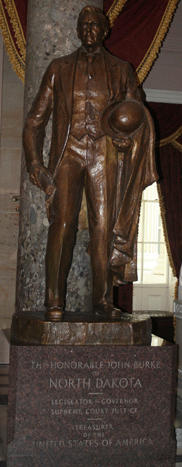North Dakota Statues
The National Statuary Hall Collection in the United States Capitol is comprised of statues donated by individual states to honor persons notable in their history. The entire collection now consists of 100 statues contributed by 50 states. North Dakota's two contributions to the collection are of John Burke and Sakakawea.
John Burke

John Burke, one of North Dakota's most acclaimed politicians, served in all three branches of North Dakota's government. He was a veteran of the North Dakota Legislature when he was elected governor of North Dakota in 1906. Burke served three terms as governor before he was named Treasurer of the United States by President Woodrow Wilson. He also served as a justice of the North Dakota Supreme Court.
The bronze statue of John Burke was given to the National Statuary Hall Collection in 1963 and was commissioned by Avard Fairbanks. The sculptor is also the maker of two other heroic statues for state representation; including Esther Morris, a woman's rights activist from Wyoming and Marcus Whitman of Washington, a medical pioneer and missionary to the Native Americans of the Northwest Territory. A similar statue of Burke resides outside of the North Dakota capitol building in Bismarck.
This statue is currently located in National Statuary Hall in the United States Capitol.
Sakakawea

Sakakawea served as a guide and translator during Lewis and Clark's famous expedition. With her son Jean Baptiste in tow, she trekked thousands of miles from North Dakota to the Pacific Ocean between 1804 and 1806. The facts of her life and travels are relatively unknown, but the stories of her bravery and independence turned her into a symbol of the women's suffrage movement and a popular hero in American culture.
In 2003, the eight foot tall bronze statue of Sakakawea and her child was given to the Capitol, marking the beginning of the bicentennial of the Lewis and Clark expedition. According to the North Dakota state legislature script, Sakakawea was chosen in order to honor her as a "traveler and guide, a translator, a diplomat, and a wife and mother" and to recognize "her indomitable spirit was a decided factor in the success of Lewis and Clark's expedition." The statue is a replica of the original done by Leonard Crunelle, which was dedicated in 1910 and stands on the grounds of the North Dakota state capitol in Bismarck. Crunelle used Sakakawea's granddaughter, Mink Woman, of the Fort Berthold Indian Reservation in North Dakota as a model for the statue. The General Foundation of Women's Clubs of North Dakota raised funds for the replica, as they did for the original statue in 1910. Unique to the statue is the appearance of Sakakawea's child, causing some controversy that North Dakota would have three bodies representing them instead of the standard two allowed for each state.
This statue is currently located in the Capitol Visitors Center of the United States Capitol.

